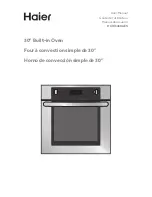
– 27 –
Main Fare Meats
For best results, select roasts that are uniform in
shape.
Place meat on a microwave rack in a suitable dish.
Beef rib roast should be placed cut-side down. Other
bone-in roasts should be placed fat-side down.
Boneless roasts should be placed fat-side up. Halfway
through cooking, turn roasts. Half hams should be
shielded by wrapping an 8 cm wide strip of foil around
the large end of the ham. Secure to the body of the
ham with wooden toothpicks. Fold 3 cm over cut
surface. For shank ham halves, shield shank bone
by cupping it with foil. One third of the way through
cooking, remove ham from oven and cut off skin. Turn
fat side up and reshield edges. If desired, glaze last
10 to 20 minutes of cooking. Loosely cover baking
dish with wax paper or paper towel to prevent splatter.
If a large amount of juice accumulates in the bottom
of the dish, drain occasionally. If desired, reserve for
making gravy. Multiply the weight of the roast by the
minimum recommended times per 500
g
. Programme
Micro Power and Time.
Meats can be shielded at the beginning of cooking or
halfway through cooking. If you wish to shield at the
Cooking Tender Cuts of Meat by Micro Power
Directions for Cooking Less-Tender Cuts of Meat by Microwave
Meat Chart for Microwave Cooking
beginning of cooking, remove foil halfway through
the cooking time. Beef and pork rib roasts should be
shielded around the bones. Foil should extend about
5 cm down from bones. The shank and thin ends of
boneless roasts should also be shielded. Make sure
foil does not touch the sides of the oven, as arcing
may occur. Canned hams should be shielded on the
top cut-edge with a 3 cm strip of foil. Wrap strip of foil
around ham and secure to body of ham with wooden
toothpicks. Fold 2 cm over cut surface. After heating,
check temperature using a meat thermometer. The
thermometer should not touch bone or fat. If it does,
the reading could be inaccurate. Lower temperatures
are found in the centre of the roast and in the
muscle close to a large bone, such as a pork loin
centre rib roast. If the temperatures are low, return
meat to the oven and cook a few more minutes at
the recommended power level. DO NOT USE A
CONVENTIONAL MEAT THERMOMETER IN THE
MICROWAVE OVEN. Let stand, covered with foil,
10 to 15 minutes. During standing time the internal
temperature equalises and the temperature rises 5°C
to 10°C.
Less-tender cuts of meat such as pot roasts should
be cooked in liquid. Use
1
⁄
2
to 2 cups of soup, broth,
etc. per 500
g
of meat. Use an oven cooking bag or
covered casserole when cooking less-tender cuts
of meat. Select a covered casserole deep enough
so that the meat does not touch the lid. If an oven
cooking bag is used, prepare the bag according to
package directions. Do not use wire or metal twist-
ties. Use the nylon tie provided, otherwise, use a
piece of cotton string or a strip cut from the open end
of the bag. Make six 2 cm slits in top of bag to allow
steam to escape. Multiply the weight of the roast by
the minimum recommended minutes per 500
g
as
suggested in the chart below. Programme Power and
Time. Turn meat over halfway through cooking. Meat
should be tender when cooked.
MEAT
POWER
APPROX. COOKING TIME
(minutes per 500
g
)
Beef
Roasts Medium
Pot Roast
Medium
Medium
12 to 14
20 to 30
Pork
Leg of Pork
Loin of Pork
Pork Chops
Medium
Medium
Medium
15 to 18
15 to 18
8 to 10
Lamb
Medium
Well
Medium
Medium
12 to 14
15 to 18
Summary of Contents for NN-ST342W
Page 40: ... 38 Panasonic Warranty Australia ...
Page 43: ... 41 Notes ...
Page 44: ... 42 Notes ...
Page 45: ... 43 Notes ...
Page 46: ...PN Printed in China Panasonic Home Appliances Microwave Oven Shanghai Co Ltd 2012 ...
















































